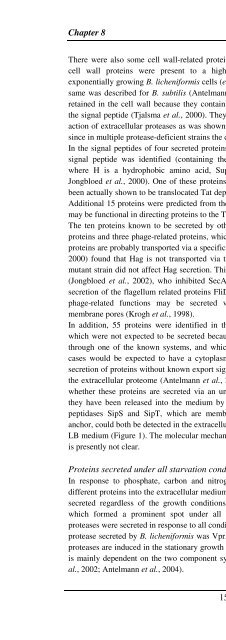The Staphylococcus aureus secretome - TI Pharma
The Staphylococcus aureus secretome - TI Pharma
The Staphylococcus aureus secretome - TI Pharma
Create successful ePaper yourself
Turn your PDF publications into a flip-book with our unique Google optimized e-Paper software.
Chapter 8<br />
<strong>The</strong>re were also some cell wall-related proteins present in the extracellular medium. <strong>The</strong>se<br />
cell wall proteins were present to a higher extent in the extracellular proteome of<br />
exponentially growing B. licheniformis cells (e.g., YvcE, YwtD; Supplemental table Vb). <strong>The</strong><br />
same was described for B. subtilis (Antelmann et al., 2002). In B. subtilis such proteins are<br />
retained in the cell wall because they contain specific wall-binding domains additionally to<br />
the signal peptide (Tjalsma et al., 2000). <strong>The</strong>y are probably released into the medium by the<br />
action of extracellular proteases as was shown by Antelmann et al. (Antelmann et al., 2002),<br />
since in multiple protease-deficient strains the cell wall proteins were stabilised.<br />
In the signal peptides of four secreted proteins found in this study, a potential twin-arginine<br />
signal peptide was identified (containing the canonical twin-arginine motif R-R-XH- H,<br />
where H is a hydrophobic amino acid, Supplemental table Vb) (Tjalsma et al., 2000;<br />
Jongbloed et al., 2000). One of these proteins is PhoD, one of the two proteins which have<br />
been actually shown to be translocated Tat dependently in B. subtilis (Jongbloed et al., 2000).<br />
Additional 15 proteins were predicted from the sequence to contain a K-R-X-H-H motif that<br />
may be functional in directing proteins to the Tat machinery (Tjalsma et al., 2004).<br />
<strong>The</strong> ten proteins known to be secreted by other pathways included seven flagellum-related<br />
proteins and three phage-related proteins, which typically lack signal peptides. <strong>The</strong> flagellum<br />
proteins are probably transported via a specific flagellum pathway. Hirose et al. (Hirose et al.,<br />
2000) found that Hag is not transported via the Sec pathway, because SecA depletion in a<br />
mutant strain did not affect Hag secretion. This was confirmed by studies of Jongbloed et al.<br />
(Jongbloed et al., 2002), who inhibited SecA activity by sodium azide and found that the<br />
secretion of the flagellum related proteins FliD and Hag was not affected. <strong>The</strong> proteins with<br />
phage-related functions may be secreted via prophage-encoded holins that can form<br />
membrane pores (Krogh et al., 1998).<br />
In addition, 55 proteins were identified in the extracellular proteome of B. licheniformis,<br />
which were not expected to be secreted because they have no predicted signal for secretion<br />
through one of the known systems, and which, taking into account their function, in most<br />
cases would be expected to have a cytoplasmic localisation (Supplemental table Vc). <strong>The</strong><br />
secretion of proteins without known export signals has been also described in other studies of<br />
the extracellular proteome (Antelmann et al., 2001; Hirose et al., 2000). It is not yet known<br />
whether these proteins are secreted via an unknown secretion mechanism, but more likely<br />
they have been released into the medium by cell lysis. Remarkably, the two type I signal<br />
peptidases SipS and SipT, which are membrane proteins with an N-terminal membrane<br />
anchor, could both be detected in the extracellular proteome of B. licheniformis cells grown in<br />
LB medium (Figure 1). <strong>The</strong> molecular mechanism underlying this unprecedented observation<br />
is presently not clear.<br />
Proteins secreted under all starvation conditions<br />
In response to phosphate, carbon and nitrogen starvation B. licheniformis cells secreted<br />
different proteins into the extracellular medium. <strong>The</strong>re were, however, also proteins that were<br />
secreted regardless of the growth conditions. Among these proteins was flagellin (Hag),<br />
which formed a prominent spot under all conditions tested. Furthermore, most of the<br />
proteases were secreted in response to all conditions, although not to the same level. <strong>The</strong> main<br />
protease secreted by B. licheniformis was Vpr. In B. subtilis the majority of the extracellular<br />
proteases are induced in the stationary growth phase (Antelmann et al., 2001). This induction<br />
is mainly dependent on the two component system DegSU and the regulator Hpr (Mäder et<br />
al., 2002; Antelmann et al., 2004).<br />
156













